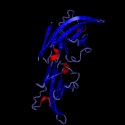CD86
CD86 (ang. cluster of differentiation 86; synonimy: B7-2, B7.2, B70, CD28LG2, LAB72[1] ) - białko występujące na powierzchni komórek prezentujących antygen i dostarczające sygnał kostymulujący limfocytom T, odgrywając tym samym zasadniczą rolę w rozwoju swoistej odpowiedzi odpornościowej. Białko CD86 jest ligandem dla receptorów CD28 i CTLA-4. CD86 zwykle współdziała z cząsteczką CD80. CD86 jest kodowane przez gen o tej samej nazwie, znajdującym się na chromosomie 3 w lokalizacji 3q21[1].
Przypisy
- ↑ a b CD86 CD86 molecule [Homo sapiens (human) - Gene - NCBI]. [dostęp 2013-09-28].
Bibliografia
- Jakub Gołąb, Marek Jakóbisiak, Witold Lasek, Tomasz Stokłosa: Immunologia. Warszawa: Wydawnictwo Naukowe PWN, 2011. ISBN 978-83-01-15154-6.
Media użyte na tej stronie
This is the crystal structure of the soluble form of CD86. It is a necessary costimulating molecule needed to activate T cells for priming of an immune response. It is known to bind CD28 and is similar in function to CD80. The original Protein Data Bank (pdb) file was published by Zhang et al (2003). I animated the pdb using PyMol. For the original pdb, see: Zhang, X., Schwartz, J.D., Almo, S.C., Nathenson, S.G. Crystal Structure of the Receptor-Binding Domain of Human B7-2: Insights into Organization and Signaling Proc.Natl.Acad.Sci.USA v100 pp.2586-2591 , 2003

